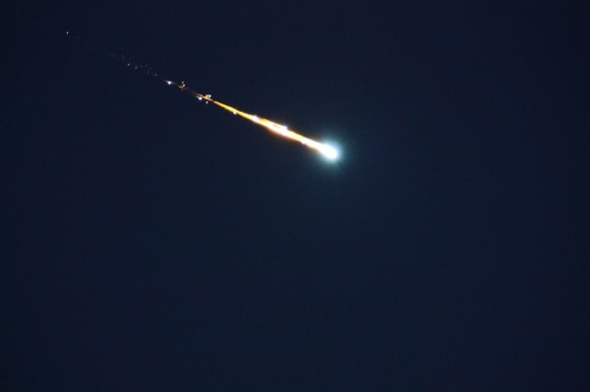Create a free profile to get unlimited access to exclusive videos, sweepstakes, and more!
Tiny Asteroid Discovered Just Yesterday “Virtually Certain” to Have
Harmlessly Impacted Earth

For just the second time in history, an asteroid was discovered before it impacted the Earth. Donât panic: It was very small, probably just a few meters across, and burned up harmlessly in our atmosphere. But after events of the past year, it underscores the need to keep our eyes open.
The asteroid is (well, was) named 2014 AA, the very first asteroid discovered this year. It was detected by the Mount Lemmon Survey using a 150 centimeter (60 inch) telescope located on a mountaintop in Arizona. The first image showing the asteroid was taken on Jan. 1, 2014, at about 06:20 UTC (01:20 EST)âtelescopes work whenever the sky is clear, holidays or no. The rock was faint, at about magnitude 19; the faintest star you can see with your naked eye is 150,000 times brighter! But an orbital calculation showed it was very close to Earth, and getting closer.
In fact, as the Minor Planet Electronic Circular discovery announcement said, âIt is virtually certain that 2014 AA hit the Earth's atmosphere on 2014 Jan. 2.2 +/- 0.4ââmeaning around 05:00 UTC Jan. 2, midnight EST, just a few hours ago. It most likely burned up over the Atlantic, somewhere between South America and Africa.
From its brightness, it was probably about two to four meters across, about the size of a car. Objects that small generally disintegrate as they ram through the Earthâs atmosphere at high speed, so there was never any big danger from this object. It orbited the Sun on a path that took it just outside the orbit of Mars to just inside our own. [UPDATE (Jan. 2 at 18:00 UTC): I had originally written the asteroid was less than two meters across, but astronomer Ron Baalke informed me that it was more like two to four meters across judging from its brightness, so I have updated the post here.]
Itâs only the second time in history that an asteroid was seen before it hit us; the first was 2008 TC3, which burned up over Sudan in Africa in 2008. That one was also discovered just a day before atmospheric entry. Other rocks have been discovered in the past that gave us a very close shave, and usually small asteroids that actually hit us go undetected until someone looks up and sees them! Thatâs because they are so small: That makes them faint and hard to detect. Because they are close by they also tend to move very rapidly across the sky, making them harder to find. The 19-meter wide asteroid that blew up over Russia last year was undetected until it hit, for example.
Itâs possible some satellites may have observed the entry of 2014 AA, and hopefully weâll get an image or two. Stay tuned.
And of course this underscores how seriously we need to take asteroid impacts. While 2014 AA wasnât a threat, there are a million bigger rocks out there that cross Earthâs orbit, big enough to cause real damage should they hit us. And given enough time, they will.
Thatâs why we need to keep scanning the skies, locating and characterizing these asteroids. Both NASA and the B612 Foundation are working on better detection methods, but thatâs only the first step; we also need a plan in place should we find one with our number on it. B612 is working on that, but weâre a long way from being able to implement it.
As usual, let me say that you shouldnât run around in circles panicking over this; after all, these are rare events. But if we do nothing at all, weâre guaranteeing that a big impact will occur sometime in the future. Like so many problems, the cost of prevention is small compared to the cost of doing nothing. We can afford the former, but not the latter.


























